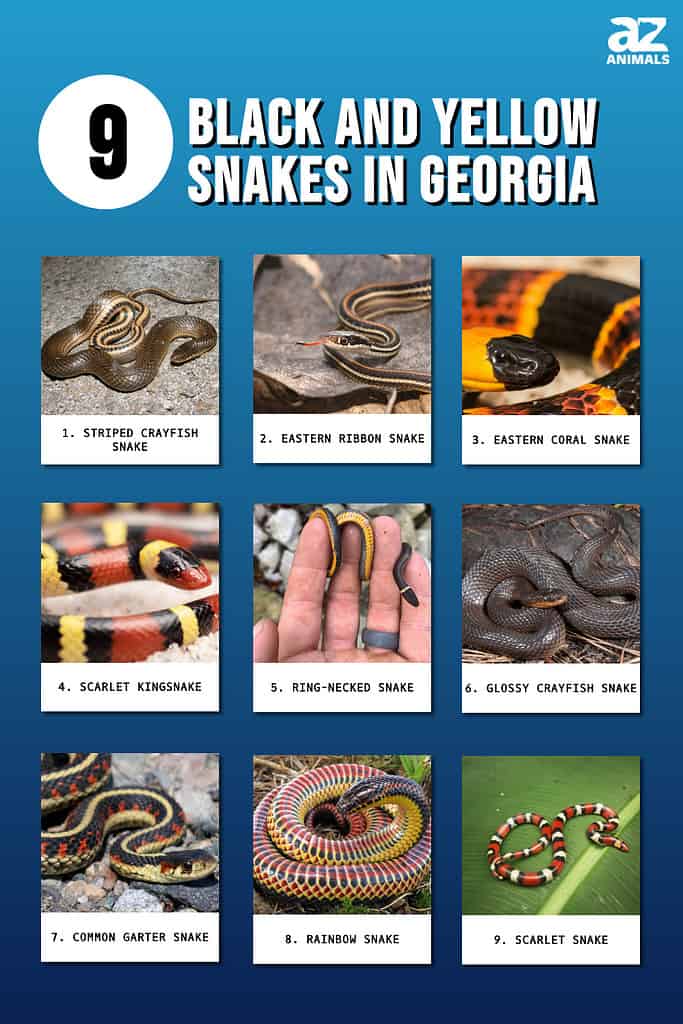
Located in the southeastern region of the US and spanning a vast 59,425 square miles, Georgia has some prime habitats for snakes to thrive in. In fact, Georgia is home to an incredible 46 different species, including six that are venomous. With so many different species, it’s not surprising to find that there are snakes with many different colors and patterns in the state. Let’s take a look at some of the black and yellow snakes in Georgia that you might encounter.
1. Striped Crayfish Snake (Liodytes alleni)

Crayfish snakes are black and yellow snakes found in Georgia that primarily prey on crayfish.
©John Sullivan / CC BY-SA 3.0 – License
The striped crayfish snake is also known as the striped swamp snake. These snakes are highly aquatic and thrive in swamps, cypress stands, saw grass prairies, and even in roadside ditches. However, although these snakes are more common in Florida, they only occur in the southern region of Georgia. Striped crayfish snakes are 14 to 20 inches long and have brownish-green bodies. They also have three dark brown to black stripes running along their body, a yellowish-colored belly, and yellow scales on their lips. As their name suggests, they prey primarily on crayfish. Although they don’t constrict their prey, they do coil themselves around their prey to hold it in place while they swallow it alive.
2. Eastern Ribbon Snake (Thamnophis saurita saurita)
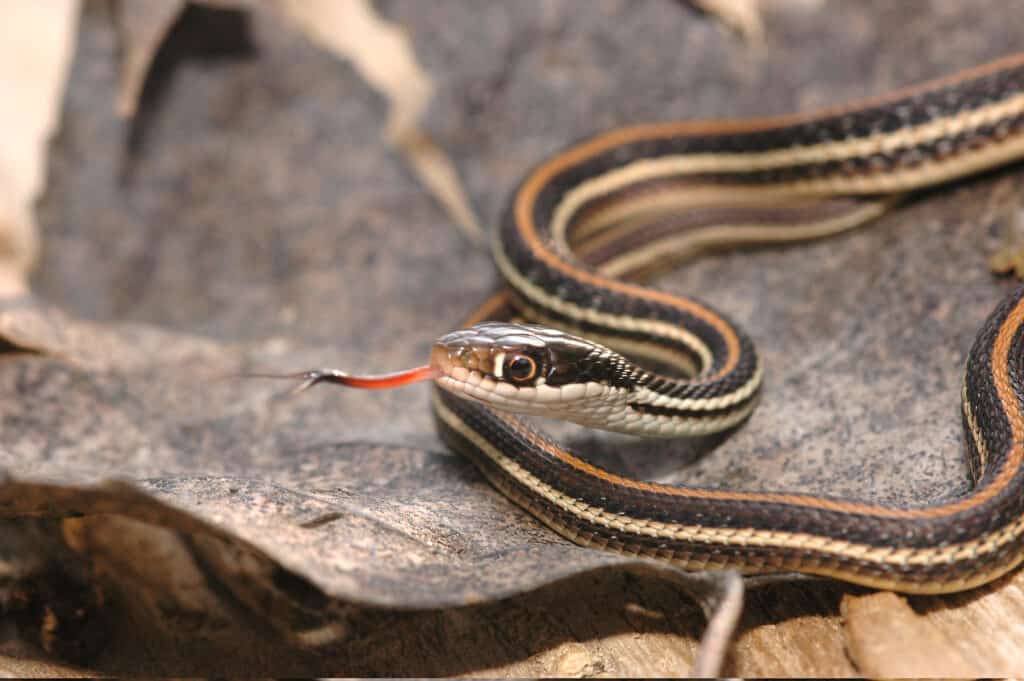
The ribbon snake is a small black and yellow snake in Georgia that lives near swamps.
©iStock.com/Shoemcfly
The next black and yellow snake in Georgia is the eastern ribbon snake which is a subspecies of the ribbon snake. Eastern ribbon snakes are 16 to 28 inches long and have black bodies with three yellow stripes. They also have yellow bars in front of their eyes. Eastern ribbon snakes are common across the majority of Georgia and live near swamps, lakes, streams, and ponds. They are semi-aquatic and prey mainly on fish and amphibians. They are not venomous and prefer to flee when threatened. However, if they are cornered they produce a foul musk scent but only attempt to bite as a last resort.
3. Eastern Coral Snake (Micrurus fulvius)

The eastern coral snake is a red, black, and yellow snake in Georgia that is highly dangerous due to its being venomous.
©Jay Ondreicka/Shutterstock.com
The only venomous snake on the list is the highly dangerous eastern coral snake. They contain mainly neurotoxic venom and prey on a variety of mammals, birds, amphibians, and even fellow coral snakes. Eastern coral snakes are 18 to 30 inches long and have distinctive bands of red, yellow, and black. The yellow bands always divide the black and red and this is the most distinctive difference between them and scarlet kingsnakes. Eastern coral snakes mainly inhabit the coastal plain where they prefer pine and scrub oak sandhills.
4. Scarlet Kingsnake (Lampropeltis elapsoides)

The scarlet kingsnake is a black and yellow snake in Georgia, but it also has red stripes.
©Radiant Reptilia/Shutterstock.com
Another black and yellow snake in Georgia is the scarlet kingsnake which has alternating bands of red, black, and yellow, with the yellow never touching the red. Although the scarlet kingsnake is often mistaken for the venomous coral snake, they are not dangerous and the common saying to remember is, “Red on yellow kill a fellow, red on black a friend of Jack”. Scarlet kingsnakes are 14 to 20 inches long and use constriction to kill their prey which consists of lizards and smaller snakes. They are fairly widespread in Georgia. However, they are more common across the coastal plain where they typically live in wet pinelands. They are secretive snakes and often hide away underneath logs and rocks.
5. Ring-Necked Snake (Diadophis punctatus)

Ring-necked snakes are the smallest black and yellow snakes in Georgia.
©CampSmoke/Shutterstock.com
One of the smallest snakes in the state is the stunning ring-necked snake which reaches only 10 to 15 inches long. Ring-necked snakes are typically glossy black to grey with a bright ring of color — either red, orange, or yellow — around their neck. Their belly also usually matches the color of the neck ring. Ring-necked snakes occur statewide and live in virtually any habitat, although they do tend to prefer woodland regions. Ring-necked snakes are completely harmless to humans as they do not contain venom in the typical sense. However, they do produce a venom-like substance in the Durvenoy’s gland which they inject into their prey using a set of small rear fangs. Their diet mainly consists of worms, slugs, and salamanders, and occasionally small frogs and lizards.
6. Glossy Crayfish Snake (Liodytes rigida)
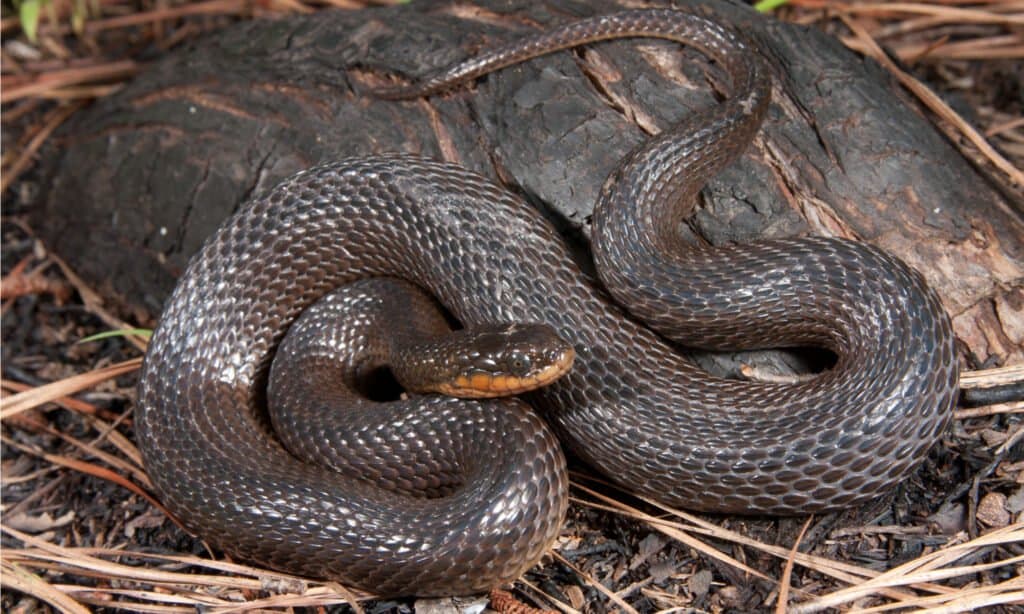
The glossy crayfish snake is a non-dangerous black and yellow snake in Georgia.
©Nathan A Shepard/Shutterstock.com
The glossy crayfish snake has a very similar appearance to the striped crayfish snake. Glossy crayfish snakes (also known as glossy swamp snakes) are 14 to 24 inches long and have glossy brown to olive-colored bodies with dark stripes down each side. They also have a yellowish-colored belly with two rows of black spots running along it. Glossy crayfish snakes are more widespread across Georgia than the striped crayfish snake but live in many of the same habitats. They are not dangerous but often hiss and attempt to strike when disturbed, though they rarely actually bite.
7. Common Garter Snake (Thamnophis sirtalis)
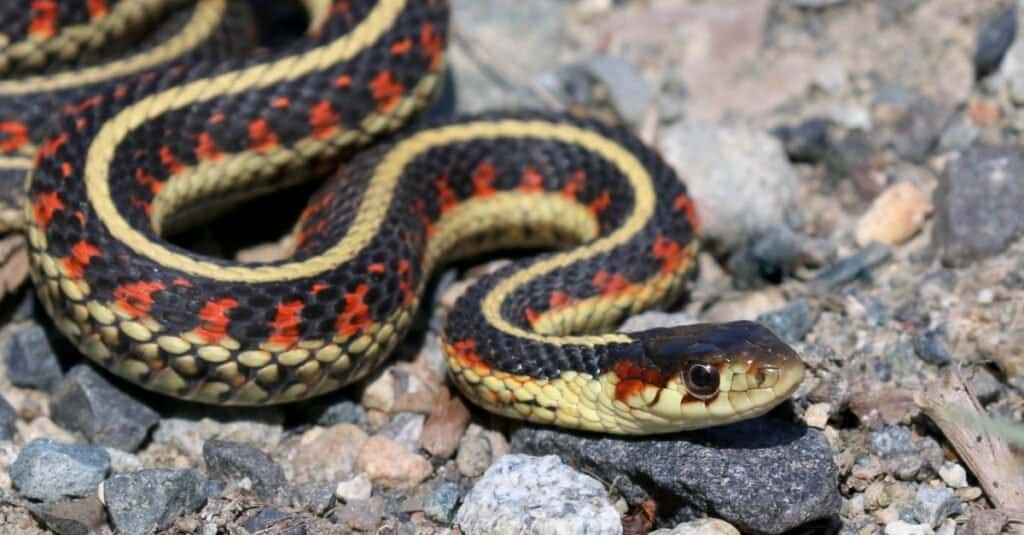
Common garter snakes are black and yellow snakes found throughout Georgia.
©iStock.com/randimal
The next black and yellow snake in Georgia is the common garter snake. Common garter snakes are typically 18 to 26 inches long. They have black, brown, or grey bodies with light, yellow-colored stripes, and a yellowish belly. They are widespread across the state and live in a variety of habitats, including fields, swamps, woodlands, and hillsides. Although common garter snakes are not dangerous to humans they do possess a mild venom-like substance in their saliva which is toxic to their prey. Incredibly, these snakes are actually immune to the toxins produced by the American toad which means that they can safely prey on them.
8. Rainbow Snake (Farancia erytrogramma)
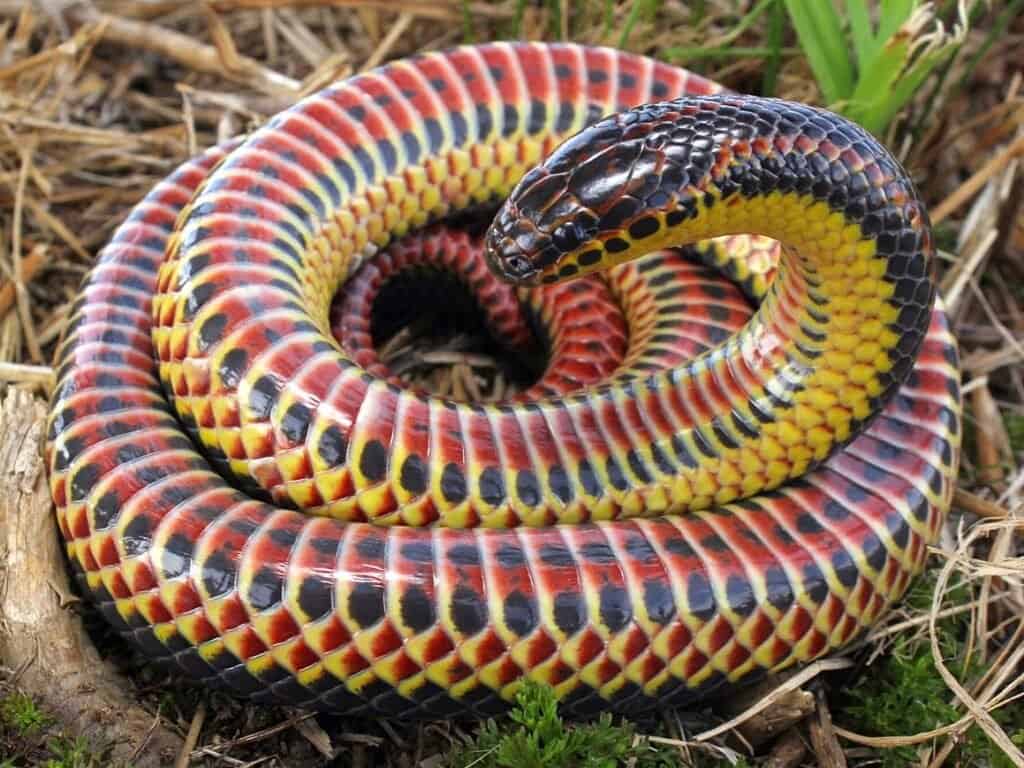
The rainbow snakes have a unique combination of black, yellow, and red.
©Charles Baker / CC BY-SA 4.0 – License
Undoubtedly one of the most unusual, yet stunning snakes is the rainbow snake. Named for its vibrant colors, the rainbow snake has a glossy black back with three red stripes. They also have a pink or red belly with two to three rows of black spots and yellow around their chin, throat, and sides. Rainbow snakes are large snakes, reaching up to 66 inches long, but are not dangerous. If disturbed they will either freeze or slither away very slowly. Rainbow snakes are semi-aquatic and can be found in rivers, streams, cypress swamps, and even in brackish water. They prey mainly on eels, which has earned them the nickname “eel moccasin”.
9. Scarlet Snake (Cemophora coccinea)
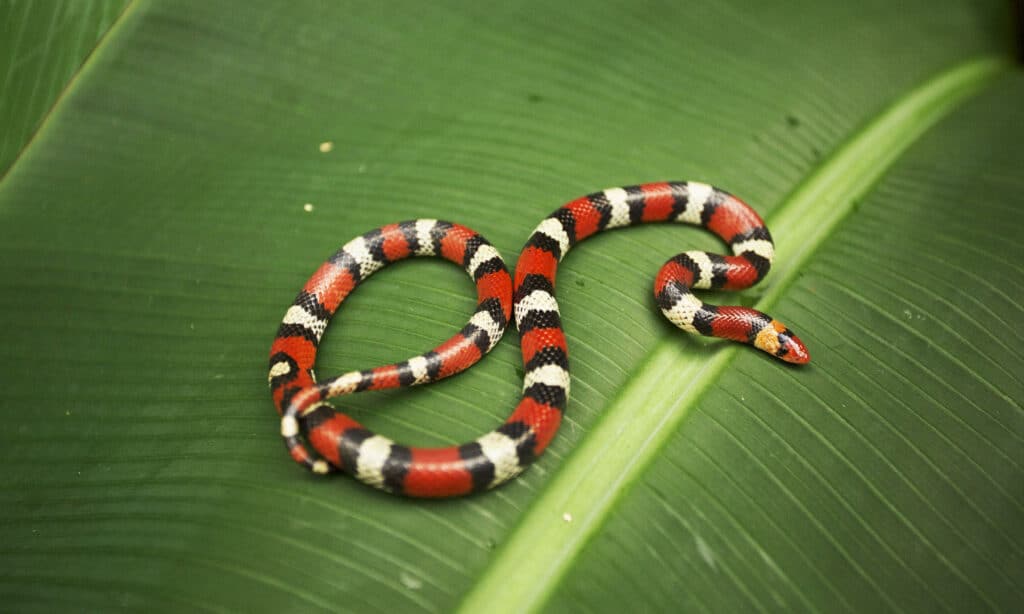
Scarlet snakes have black and yellow bands on their red bodies and are nonvenomous.
©Fine Art Photos/Shutterstock.com
The final snake on our list is the scarlet snake which is a relatively small snake at only 14 to 26 inches long. Scarlet snakes have alternating bands of red, black, and yellow or white. However, the red bands are always outlined in black so that they never touch the yellowish color. Scarlet snakes are burrowers and live in pine flat woods and hardwood hammocks. They are widespread across Georgia but are absent from the mountainous regions in the north. Scarlet snakes are not dangerous and do not typically bite when handled, although they do produce a foul-smelling musk as a deterrent.
Summary of 9 Black and Yellow Snakes in Georgia
| # | Snake | Habitat |
|---|---|---|
| 1 | Striped Crayfish Snake | Swamps, cypress stands, saw grass prairies, and roadside ditches |
| 2 | Eastern Ribbon Snake | Swamps, lakes, streams, and ponds |
| 3 | Eastern Coral Snake | The coastal plain – pine, and scrub oak sandhills |
| 4 | Scarlet Kingsnake | The coastal plain – in wet pinelands, underneath rocks |
| 5 | Ring-Necked Snake | Prefer woodlands but can live anywhere |
| 6 | Glossy Crayfish Snake | Swamps, cypress stands, saw grass prairies, and roadside ditches |
| 7 | Common Garter Snake | Fields, swamps, woodlands, and hillsides |
| 8 | Rainbow Snake | Rivers, streams, cypress swamps, and brackish water |
| 9 | Scarlet Snake | Pine flat woods and hardwood hammocks |
The photo featured at the top of this post is © Rusty Dodson/Shutterstock.com
Discover the "Monster" Snake 5X Bigger than an Anaconda
Every day A-Z Animals sends out some of the most incredible facts in the world from our free newsletter. Want to discover the 10 most beautiful snakes in the world, a "snake island" where you're never more than 3 feet from danger, or a "monster" snake 5X larger than an anaconda? Then sign up right now and you'll start receiving our daily newsletter absolutely free.
Thank you for reading! Have some feedback for us? Contact the AZ Animals editorial team.






